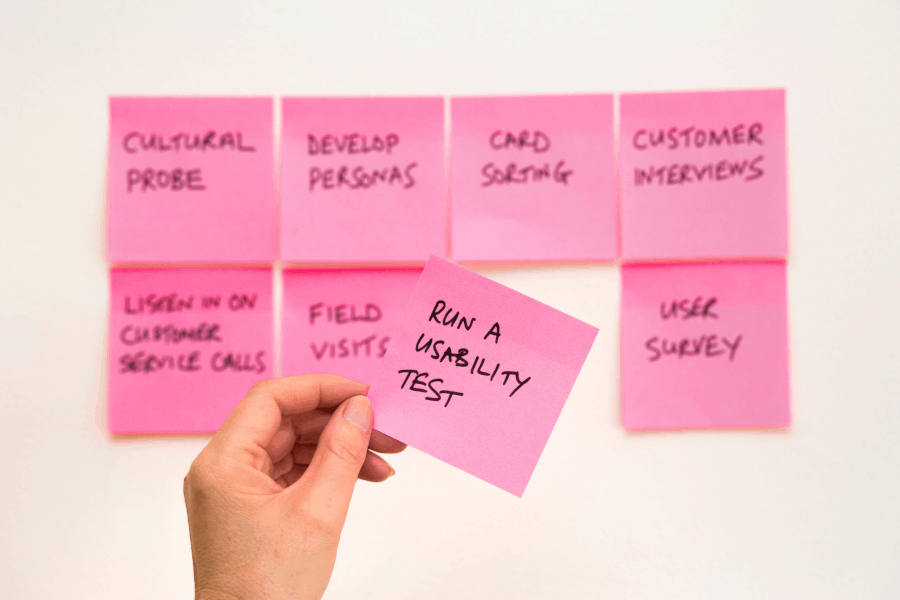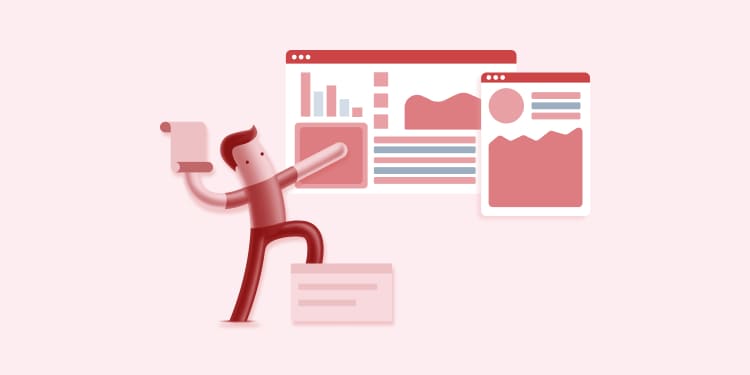ARTICLE SUMMARY
The design thinking process is a human-centric approach to innovation that allows for a deeper understanding of the customer's issues.

If you’re already familiar with Design Thinking and its concepts, it’s time to put this knowledge into practice. Even though we won’t look back to some of its basic concepts, we’ll go over the design thinking process here and its stages.
Even though it’s frequently seen as a path towards innovation, the design thinking process is not the same as the traditional innovation process. For starters, the number of stages is quite different.
While the traditional innovation process has four stages (ideate, define, design and develop), the design thinking process has five (empathize, define, ideate, prototype, and test). It’s also important to notice that the steps of the design thinking process are not linear, they work cyclically and dynamically towards developing and launching innovative ideas.
The design thinking process has the ultimate goal of bringing out ideas, making choices about them and going back and forth in order to thoroughly develop them. So, let’s dig deeper and learn more about each one of these five stages.
1- Empathize
According to the Merriam Webster dictionary, empathy is:
The imaginative projection of a subjective state into an object so that the object appears to be infused with it. The action of understanding, being aware of, being sensitive to, and vicariously experiencing the feelings, thoughts, and experience of another of either the past or present without having the feelings, thoughts, and experience fully communicated in an objectively explicit manner.
Simply put, empathy means putting yourself in someone else’s shoes. In the design thinking process, it means listening and understanding the needs of customers or your target audience. It means looking at a problem/situation through your customer’s eyes other than your own.
Being a human-centered process in itself, empathizing allows professionals to acquire a deeper, more personal understanding of the issue at hand without relying on his/her own assumptions. You have to set your own point of view aside from your customers and stick to theirs.
2 – Define
The second stage of the design thinking process involves combining and analyzing all the insights and information you gathered by observing people in the first stage.
By exploring your newfound knowledge, design thinkers begin to synthesize them to define the core-problems you’ve identified. The main goal in this stage is framing the problem clearly and defining it as a problem statement.
The clearer your problem statement is, the larger the possibility of finding alternative solutions to it. This stage is also about gathering ideas that can solve this problem (or help the customer solve it as easily as possible).
3 – Ideate
Now that we’ve gone over the ‘defining the problem’ stage, it’s time to interpret it in many ways and brainstorm (or ideate) as many solution ideas as possible.
As the brainstorming concept states, make sure you and your team don’t overlook any ideas, no matter how easy or obvious they may seem. Seemingly simple, obvious solutions can be the starting point for brilliant solutions.
Keep an open mind and explore each presented idea with an unbiased point of view.
4 – Prototype
The prototype phase of the design thinking process is all about creating simple visual representations (sketching, roughly prototyping, etc.) of the previously defined solutions to evaluate how beneficial they’ll be for the product.
This phase is about creating simple drafts, so make sure to adopt a practical, economical and fast approach to prototyping. Later on, you and your team will develop the concept further.
The prototype phase is experimental and its main goal lies in identifying the best solution possible for each of the previously identified problems. Before moving on to the next stage, the design thinkers should have already identified the customer’s perspective, the existing problems and the product’s constraints.
5 – Test
The testing phase, even though the name is pretty much self-explanatory, is about testing the prototype(s) with the targeted audience and measuring their understanding and response to the presented solutions.
I cannot stress how important it is to run complete tests of all the best solutions identified and prototyped in the previous phase. Considering the fact that the design thinking process is mostly iterative, the results obtained in this phase are constantly used to refine and redefine the solutions until they assume the best possible format for the end-user.
Other than just empowering multi-disciplinary teams to create innovative solutions focused on their defined audience, the design thinking process allow these teams to really define and understand the user experience. Pipefy is a great platform for that since it enables team collaboration, centralization of information and keeps everyone updated.
Via the design thinking process, people will have to deal with real user issues and focus on creating features/products that solve these actual problems. It’s not about simply building new features, it’s about building specific features for a specific audience – and that’s where the whole design thinking process shines.









